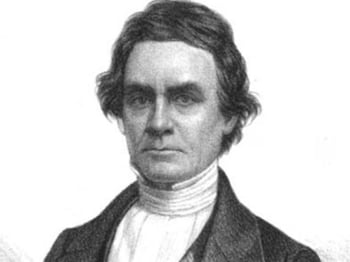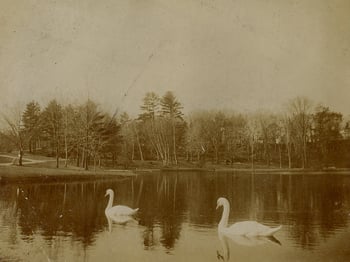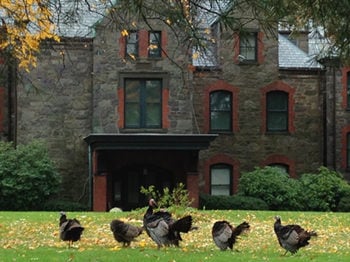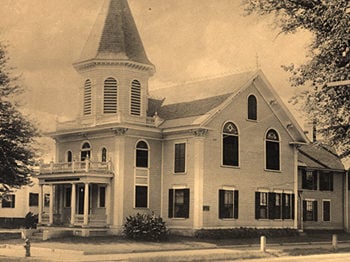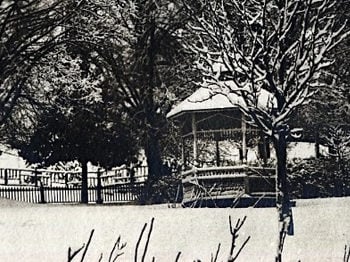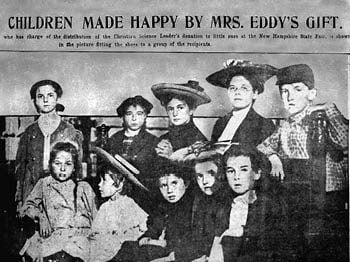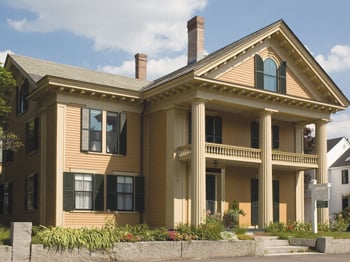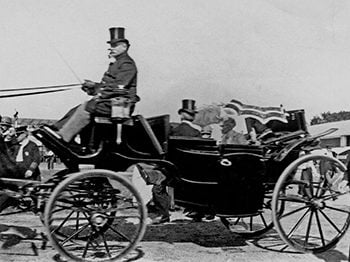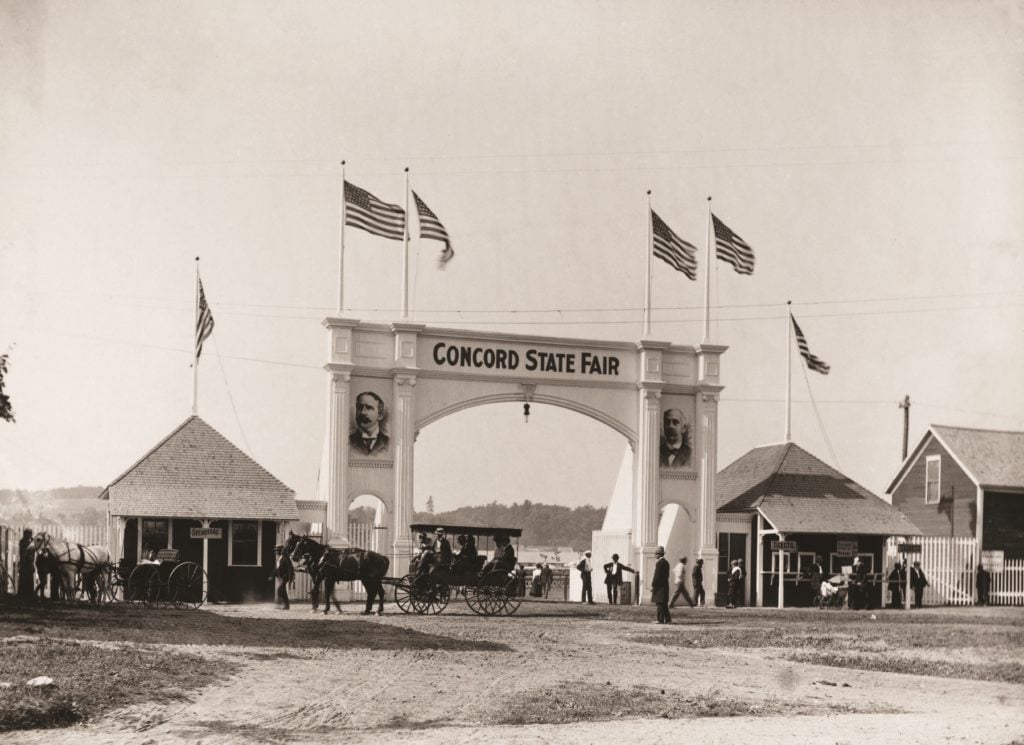
Pleasant View was aptly named. From the vantage point of the double verandas stretching across the back of Mary Baker Eddy’s modest but gracious country home in Concord, New Hampshire, the grounds sloped away to the south toward a small pond. A tidy gravel path traversed the lush lawn, passing shade trees and an apple orchard and an ornamental gazebo on its way to the white clapboard boathouse at water’s edge. In high summer, daisies and other wildflowers nodded in the passing breeze, framing the panoramic Bow Hills where Mrs. Eddy had spent her childhood.
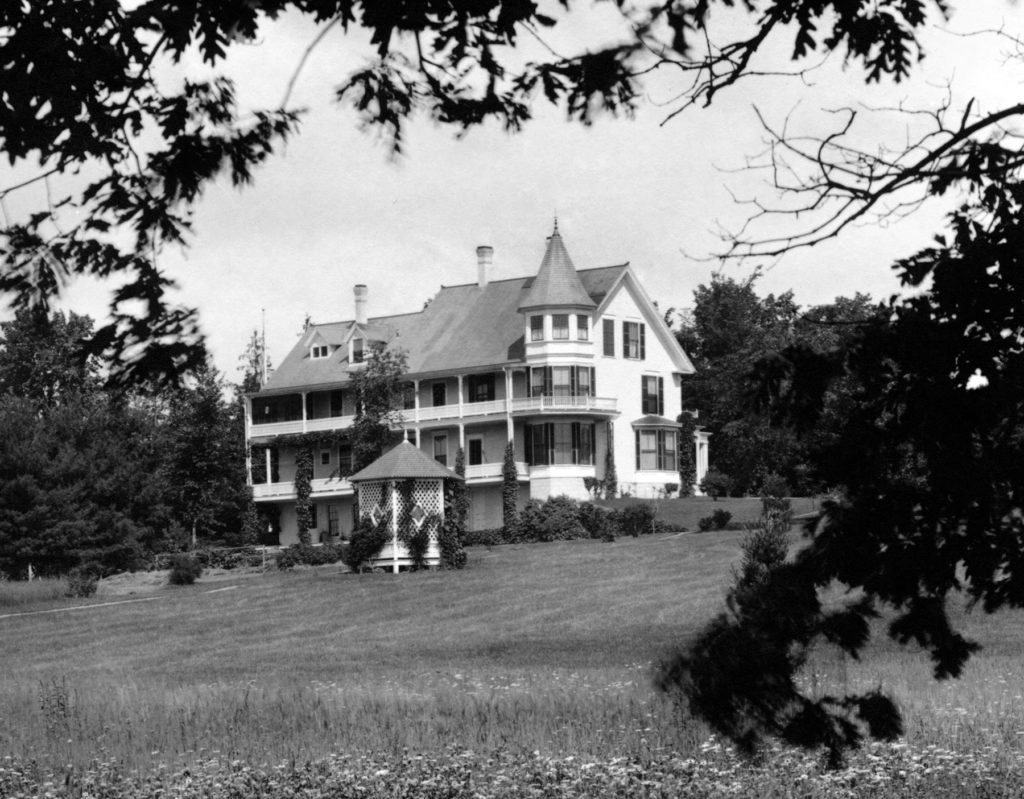
The pastoral view was designed to be enjoyed, and it was enjoyed — by the woman whose tower study windows took full advantage of the prospect, by the members of her household, and by those who came from Concord and Boston and points beyond to find themselves greeted by what a local newspaper described as “a paradise Mrs. Eddy has prepared for all lovers of the beautiful in nature….”1
In the spring of 1900, just about the time of year that Concord residents began flocking to Pleasant View to see the tulips in bloom, a state fair association was organized. When word came that the old trotting park adjoining the southern edge of Mrs. Eddy’s property was to be developed for the new fairgrounds, it wouldn’t have been surprising if the owner of a home whose vista’s “deepest note” was peace,2 as one journalist observed, had taken exception to the plan.
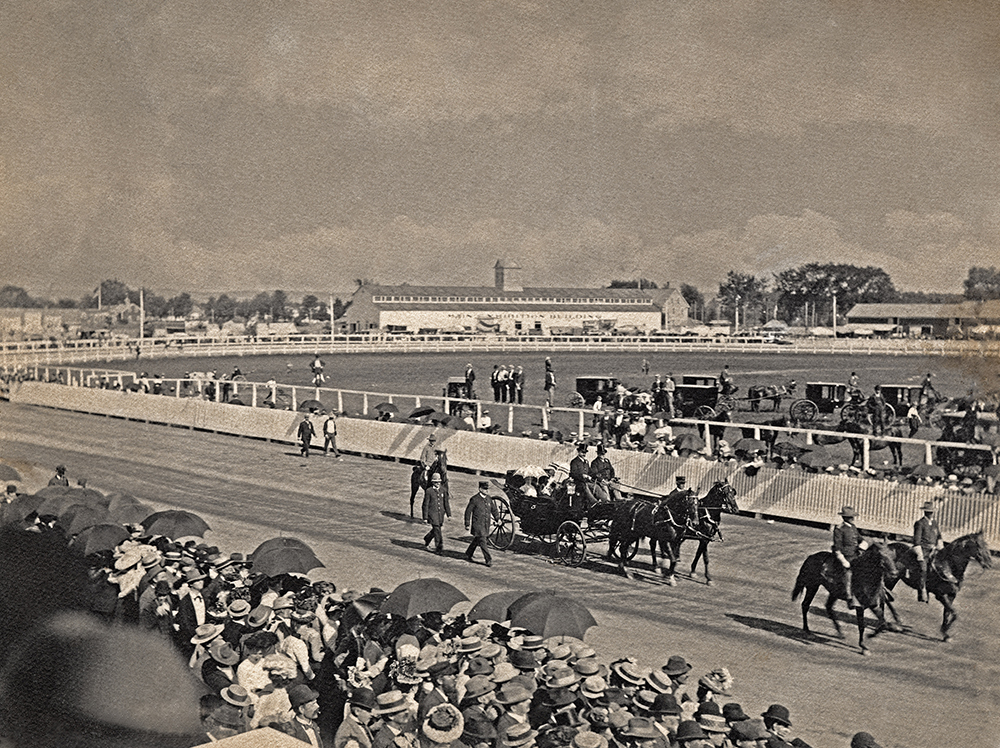
Instead, she wrote a check in support of it.3
A public-spirited citizen
Mary Baker Eddy had lived in Concord for a decade by this point, eight of those years at Pleasant View.4 To borrow an old Yankee term, she “neighbored well” — donating generously to local causes, sharing her farm’s bounty with friends and neighbors, and transforming her property on the outskirts of town into a source of civic pride.
“Shopping local” long before it became a popular trend, Mrs. Eddy was a staunch supporter of her hometown’s businesses. A Concord florist designed and planted her garden beds;5 footwear was purchased from Thompson’s Shoes [see sidebar];6 her piano was a Prescott, a local instrument manufacturer whose advertisement would appear on the side of the new fairground’s exhibition hall. She gave to the city’s auditorium fund, the New Hampshire Historical Society, the local firemen’s organization, and the local Y.M.C.A., among numerous other causes. She helped spearhead the paving of Concord’s roads,7 and donated a pair of “stately swans … to glide with attractive grace” on the pond in White Park.8 The Eagle Hotel and other downtown establishments did a brisk business whenever groups of her followers came to visit.
Her philanthropy knew no geographical bounds — she also gave to victims of fire and flood and earthquake in such farflung locations as San Francisco and Sicily. She sent money to refugees in Macedonia, to museums and colleges and libraries, to other churches, and even to hospitals.9
“The thing most important is what we do, not what we say,” she once wrote in a letter accompanying a donation for a proposed monument in New York’s Central Park.10
Mrs. Eddy’s giving wasn’t limited to dollars. For example, she made sure that volunteer soldiers training near Concord for the Spanish-American war had fresh fruit and a hot meal, shared flowers from her garden with the Daughters of Veterans to use on Memorial Day, and invited neighbors to pick apples from her overflowing orchard.11
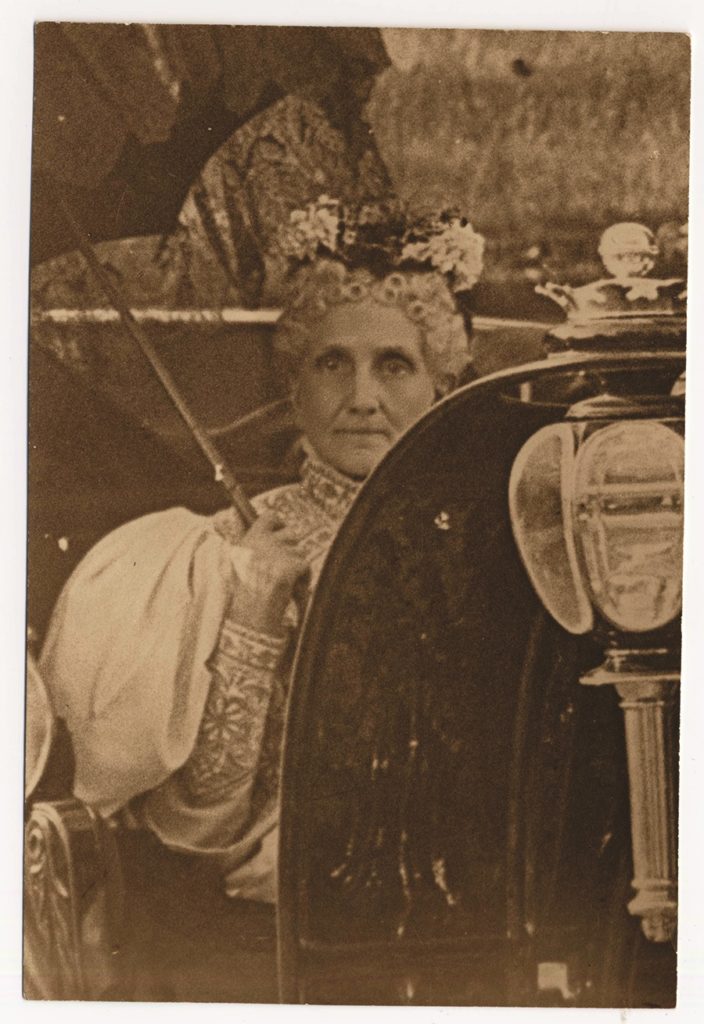
“She has proved herself a public-spirited and generous citizen, and her interest in the growth and improvement of the city has been shown in many ways,” local author James O. Lyford would write in 1903. “Even those who are not of her faith acknowledge the correctness of her life, the benevolence of her character, and the public spirit she manifests on all occasions.”12
Concord was clearly fond of Mary Baker Eddy, and so it was only natural that she would receive an invitation to the city’s inaugural fair. It was an event she would happily attend both that autumn and the following one, and her twin appearances offer a window into the measure of esteem in which she was held by her hometown, and the wider world beyond.
“A picture not soon to be forgotten”
The summer of 1900 had been a busy one for Mrs. Eddy. She was in the middle of a grueling lawsuit brought by disaffected student Josephine Woodbury.13 She’d written a message to be read at the communion services at The Mother Church in early June,14 greeted her followers who visited Pleasant View afterwards, and as summer ripened into fall, delivered what would be her final public address, given to the First Members of The Mother Church at Christian Science Hall in Concord on Wednesday, September 5. The group of 40 would stay the night in Concord and accompany Mrs. Eddy to the fairgrounds the following day.
After an evening lit by a harvest moon, Thursday dawned bright and clear.15 It was Governor’s Day at the fair, and a full schedule of events awaited. The ambitious motto on the cover of the fair’s program (“Open to the World”) must have seemed prophetic to the crowds who arrived by rail, or in horse-drawn carriages, or by trolley, or on foot. All told, some 25,000 people, more than the entire population of Concord,16 headed to the 60-acre parcel of land at City Park Drive that day. The new grandstand overlooked a half-mile oval track ready to thrill onlookers with displays of horsemanship, bicycle races, and the novel sight of a horseless carriage race — the first ever at a New England fair.17 Farmers proudly showed off their livestock, from pigs and poultry to “sleek and powerful oxen.”18 Over in the exhibition hall, homemade jams and jellies and the like were displayed alongside such fancy work as embroidery, lace, and quilts. Visitors could picnic in the grove, enjoy a glass of Concord’s own vigorously advertised “Berry’s Famous Root Beer,” watch a baseball game or a balloon ascension, and take in one of the many stage shows, including Professor Keller’s Dog Circus, featuring “The Dog Blondin,” who walked a tightrope blindfolded.19 Not to be overlooked was that staple of every state fair, the midway. Its numerous attractions— including Bostock’s Wild Animal Arena—would all be in keeping with the “high moral standard of this fair,” the promoters promised.20
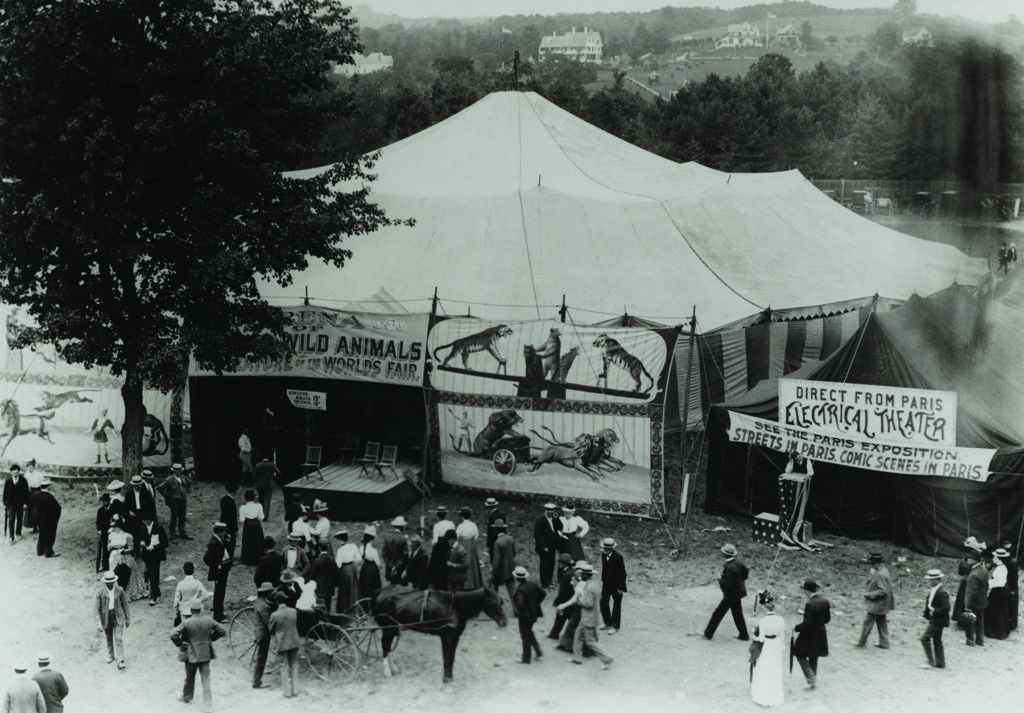
Governor Frank Rollins and his entourage arrived at 10:30 with much pomp and ceremony. He and his wife were joined in the governor’s box by such local luminaries as Mrs. Eddy’s lawyer cousin and good friend Henry Moore Baker,21 along with William Chandler, former U. S. Senator and Ex-Secretary of the Navy, now publisher of the Concord Monitor.22
“The feature of the day,” however, reported the Boston Globe, “was not on the set program.” It was the appearance of Mary Baker Eddy.
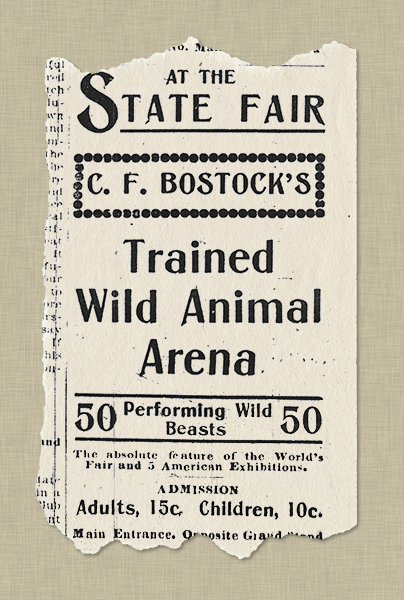
“She arrived at the main entrance at 3 o’clock,” the newspaper report continued. “The races on the track were immediately suspended and, under the escort of mounted police with patrolmen on either side of her carriage, Mrs. Eddy drove around the race track in her victoria, drawn by a pair of handsome bays.”23
The horses were Prince and Duke, Mrs. Eddy’s favorite team.24 At the reins was coachman August Mann; beside him sat Judge Septimus J. Hanna, First Reader of The Mother Church in Boston and editor of the Christian Science periodicals. His wife Camilla, who was serving as assistant editor, sat beside Mrs. Eddy in the carriage.
Mrs. Eddy “looked remarkably fresh and fair for a woman of 80 years,” noted the Boston Globe, “and in her quiet dress of lavender shade presented a picture not soon to be forgotten.”
As the carriage neared the governor’s reviewing stand, Mrs. Eddy “was announced to the throng as the Rev. Mary Baker Eddy, the Discoverer and Founder of Christian Science. The band struck up a patriotic air and the ten thousand spectators in the amphitheater waved handkerchiefs, cheered, and applauded.”25
Mrs. Eddy “bowed right and left and seemed to enjoy greatly seeing again her old New Hampshire friends,” notes John Lathrop, one of the First Members present that day.26 By all accounts, Mrs. Eddy also enjoyed the afternoon’s activities.27 In fact, the horses “so delighted her that she stood up in her carriage to clap her hands at the victory of one beautiful trotter.”28
Of particular interest was Oscar Norin. The daring young Swede had made a name for himself with his fearless highdiving displays, especially the “sensational fire dive,” in which he would festoon himself with fireworks, set his costume aflame, or dive through a blazing hoop from a great height into a small pool of water below.29
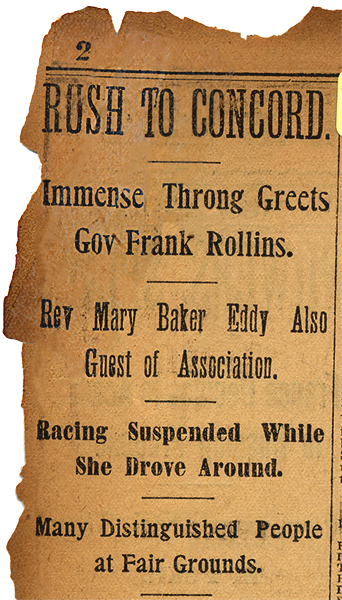
“Mrs. Eddy had told Judge and Mrs. Hanna…that she looked upon the exhibition as an example of overcoming fear and wanted to see it,” Mr. Lathrop recalls.30 Accordingly, her carriage was driven closer to the 80-foot tower where Norin, “dressed as Mephistopheles in red and with a tail,” would attempt his feat.
“The moment arrived,” Lathrop continues, and Norin “gracefully dived downward through the fiery circle into the water, coming quickly to the surface. He walked out and up to Mrs. Eddy’s carriage, bowed low to her, and ran off.”
Afterwards, Mrs. Eddy famously quipped to the Hannas, “I beheld Satan as lightning fall from heaven.”31
Back at home, Mrs. Eddy dashed off a letter to George Moses, editor of the Concord Monitor and on the executive committee for the fair, thanking him and his fellow officials for their warm welcome. Mr. Moses replied: “The main thing about your visit which should be remembered, as I regard it, is the genuine spontaneity of your reception. Nothing was prearranged, nothing was studied. It was the true recognition of your personality — and as such is worthy to be cherished as indicating the real feeling of the people.” He closed with the hope that she would attend future Governor’s Days at the fair, when she could “fitly share with ‘The First Citizen’ the honors of ‘The First Resident’ of the state.”32
His words touched Mrs. Eddy deeply. “I had no intimation, and no idea, of the kind care and honor that you had in store for me, till I met the situation,” she wrote back. “It was indeed mutually spontaneous, a gentle effusion from the heart of the metropolis of my native state that will never pass from my memory, nor cease to cheer it.” She enclosed a check for $1,000, “to be applied for aiding the improvement of the exterior of the buildings on the fair grounds — including the cupola on the main building.”33
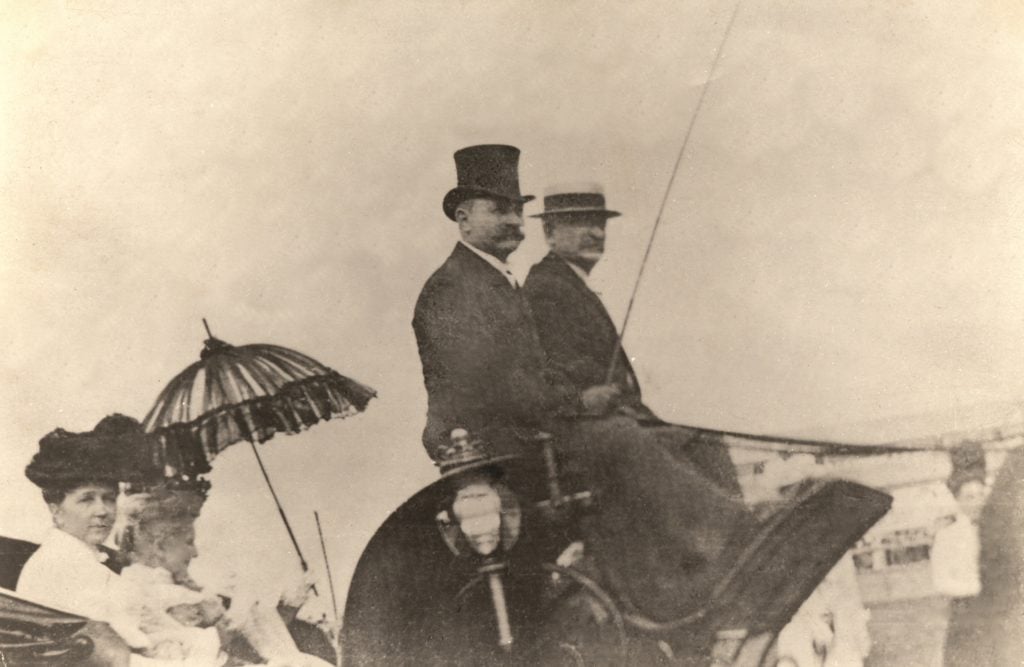
Generosity’s childhood roots
Raised in a deeply Christian home, generosity and neighborliness were as firmly established in Mary Baker Eddy’s character as was the granite in the soil of her native state. “My childhood’s home I remember as one with the open hand,” she would recall. “The needy were ever welcome….”34
Their lives guided by the Bible teachings they revered, Abigail and Mark Baker took to heart Jesus’ command “Love thy neighbor as thyself,”35 giving of their time, their talent, and their means to those in the small farming community in which they lived. Their daughter followed suit — sometimes too eagerly, as when young Mary gave away the coat her mother had labored to make for her to a less-fortunate schoolmate.
The generous spirit that inspired such childhood deeds would eventually ripen into a far deeper sense of charity, or “spiritual love,” as Mrs. Eddy would come to define it36 — one that yearned to help and heal her fellow man. She would allude to this cherished desire in the preface to Science and Health with Key to the Scriptures: “In the spirit of Christ’s charity, — as one who ‘hopeth all things, endureth all things,’ — and is joyful to bear consolation to the sorrowing and healing to the sick, — she commits these pages to honest seekers for Truth.”37
Mary Baker Eddy and the religion she founded would touch the lives of countless such seekers, including two during her state fair appearance in 1901, transforming both in ways they could hardly have imagined.
Welcoming New Hampshire’s “First Resident”
1901 was equally as productive as the year that preceded it. In April, Mrs. Eddy gave a major interview to the New York Herald. The Woodbury suit continued to drag on, but was finally decided in Mrs. Eddy’s favor in early June.38 Later that month, on Sunday, June 23, her ninety-minute message to The Mother Church was read aloud during four packed communion services. It would be printed in full in newspapers eager to cover the growing religion.
On Monday, June 24, Mrs. Eddy surprised her followers with an invitation to Pleasant View for the following day. Nearly 3,000 people showed up to hear her brief message and tour the grounds.39 And then in late August, Mrs. Eddy invited the First Members of her Church to the Concord State Fair.40 She notified George Moses that she would be accepting his invitation, and planned to bring Judge William Ewing and his wife, Ruth, as her honored guests.41
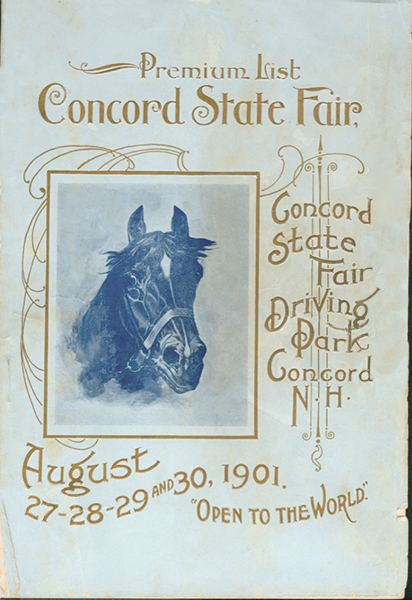
Promptly at 1:00 P.M. on Wednesday, August 28, the Ewings arrived at Pleasant View. Under Mrs. Eddy’s direction, household cook Minnie Weygandt had prepared a festive meal of “mock bisque soup, cold roast chicken, cranberry jelly, mashed potatoes, green peas, lobster salad, apple pie, ice cream, cake and assorted fruit.”42 An amusing scene played out at the dining room table, when it turned out that, not knowing until the day before that he would be riding in Mrs. Eddy’s carriage, Judge Ewing hadn’t brought along a proper silk hat. The only ones available in Concord stores were used, “and he had explained to the storekeeper that if he bought a hat, he should insist upon its being a new one.”
Irving Tomlinson offered to lend his, but it was too large and out of style. At this point, Mrs. Eddy “walked around the table to Judge Ewing as though an inspiration had come to her, and encircled the crown of his head with her hands saying, ‘I think we have a hat that will be a perfect fit for you.’” She proceeded to offer him Calvin Frye’s brand new one, which he had ordered from Boston for the occasion (“his old one would be entirely in keeping” for Mr. Frye, Mrs. Eddy assured her guests). The hat fit, and the day, along with Judge Ewing’s dignity, was saved.43
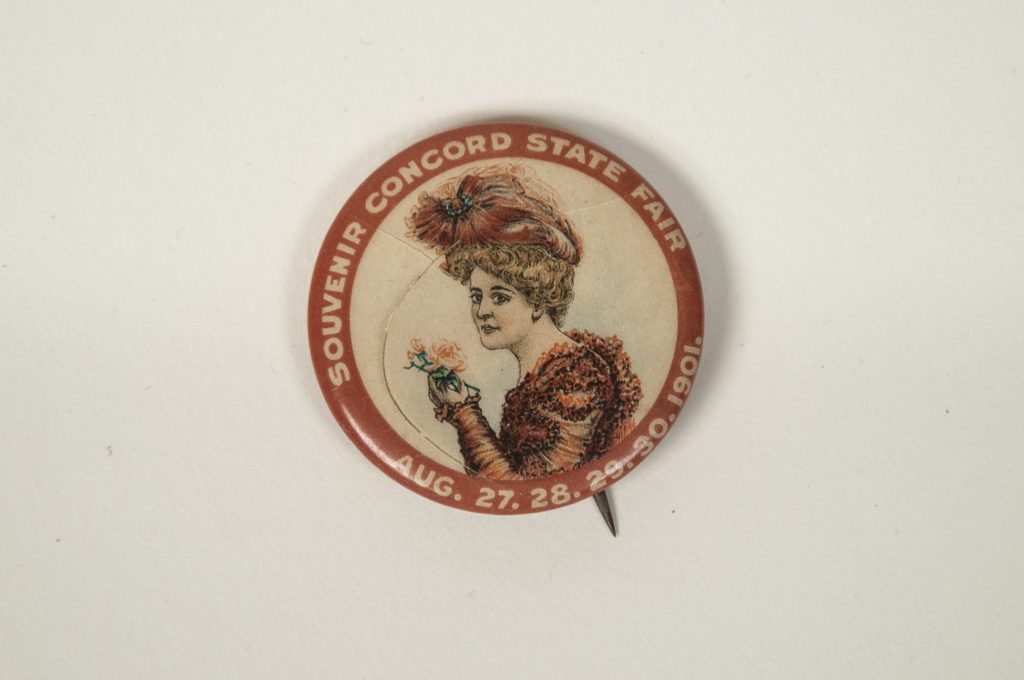
It was another beautiful day for a fair, and once again, a large crowd turned out for Governor’s Day.44 By noontime, a dozen excursion trains from around the state had unloaded their passengers,45 among them 600 Christian Scientists on a pair of special trains from Boston. As before, there was “plenty doing,” as the Boston Globe put it, to keep everyone entertained at the fairgrounds. The midway, where “every conceivable kind of an attraction”46 vied “to pull dimes and nickels from the pocketbooks of visitors,” was serving up hot dogs, popcorn, ice cream, and sideshows, all with their hawkers (who sounded “just like a flock of crows,” according to Pleasant View groundskeeper John Salchow,47 who had followed Mrs. Eddy to the fair on his bicycle). Over on the big stage by the grandstand, a full program of vaudeville acts ran continuously. One of those acts was a husband-and-wife bicycling duo billed as the Martelles. Their real names were Harry and Emma Blaney, and before the day was through Emma would have her first glimpse of Mary Baker Eddy, a brief encounter that would bear fruit in healing, permanently altering the trajectory of her life [see sidebar].
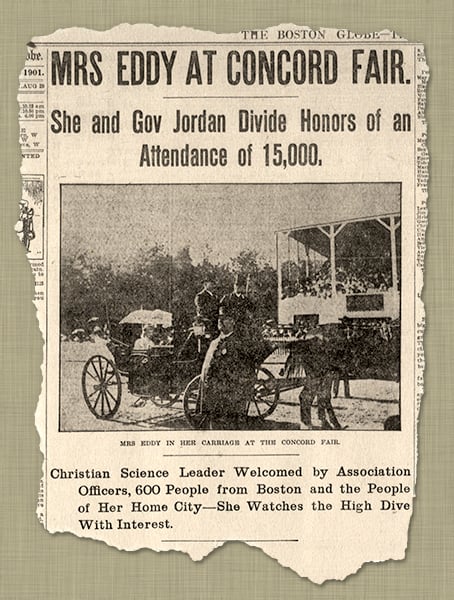
“The crowds kept coming all through the day and evening from all parts of the state — from all parts of the country for that matter,” observed the Boston Globe, “as this fair has at least one attraction that is able to bring people from the farthest corners of the land right into the grandstand, which no other fair can hope to possess. That attraction is Mrs. Mary Baker G. Eddy, the head of the Christian Science Church.”48
New Hampshire had a new governor to welcome — Chester B. Jordan, “but he was, after all, only a side issue compared with Mrs. Eddy,” the Globe opined. “It was really her day as well as the governor’s, and when her landau came on the grounds more necks were strained to get a glimpse of it than were to see the governor and his staff and brass band.”49
Shortly after his arrival with his family, Governor Jordan gave a speech, joking that he should have brought his two boys the day before, when Mrs. Eddy had provided some 200 pairs of shoes to needy children. Alas, he said with mock regret, it looked as if his sons would have to go to school barefooted that winter, “as his salary was small and his means limited.”50 On a more serious note, he praised the generosity of the “noble, good woman” who would shortly be joining them, adding, “The science which has such a large measure of Christianity attached to it is a science worth sticking to.”51
At 2:45, Mrs. Eddy’s carriage — a handsome rented landau this year — entered the grounds with a mounted escort52 and drove slowly down the track. Calvin Frye (graciously wearing his old hat) was perched next to coachman August Mann. Mrs. Eddy, in a pearl-colored dress, was seated in the carriage with Judge and Mrs. Ewing.53 As they approached the grandstand, “one great white sea of waving handkerchiefs” fluttered in greeting.54 A brass band struck up “Columbia, the Gem of the Ocean,” and the afternoon entertainment was suspended while George Moses, chairman of the fair association’s executive committee and designated spokesman, doffed his hat to officially welcome Mrs. Eddy.55
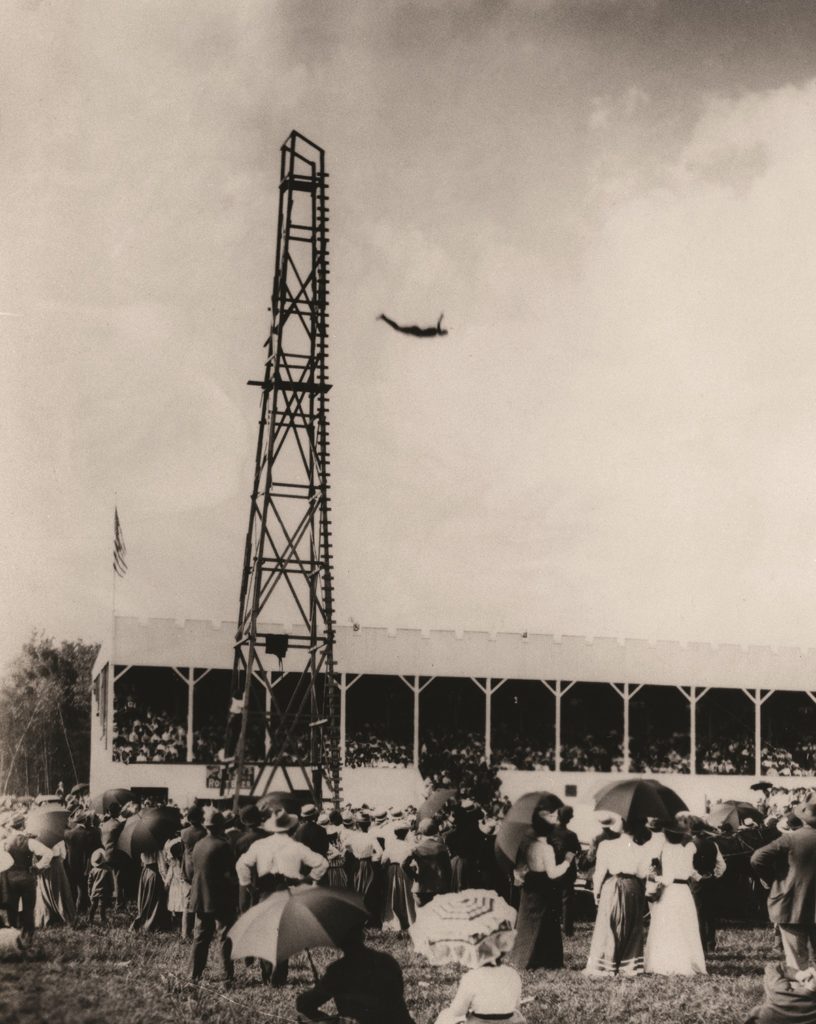
She bowed gracefully, acknowledging his brief remarks, and then it was time for high diver Oscar Norin, whose feats of daring Mrs. Eddy was again keen to see. Like Emma Blaney, Mr. Norin, too, would shortly have a life-altering encounter with the Leader of the Christian Science movement.
His aerial display “brought a smile of approval from his distinguished spectator.”56 As Mrs. Eddy’s carriage pulled away, she waved her handkerchief at the “thousands who were waving theirs in the grandstand and grounds.”57 Afterwards, Mary Godfrey Parker, a Christian Scientist who had traveled with her husband to the fair, recalls “there was such a jam at the entrance that it took some time for her carriage to drive through, but she sat there quite unperturbed, bowing and smiling to everyone.”58
Back at home, Mrs. Eddy once again took pen to paper to thank the fair’s organizers. In her letter to general manager Lewis Hoit, she enclosed a check for $500 for the benefit of the state fair association,59 and to George Moses and the other officers, she noted, “I beg to say that my brief visit to the grounds was a pleasant rest for me — your polite, tender, impressive reception of me, Judge Ewing, Mrs. Ewing, and the visiting Christian Scientists greatly appreciated. Accept my thanks, and long live my fair neighbors.”60
A “revolutionary” philanthropy
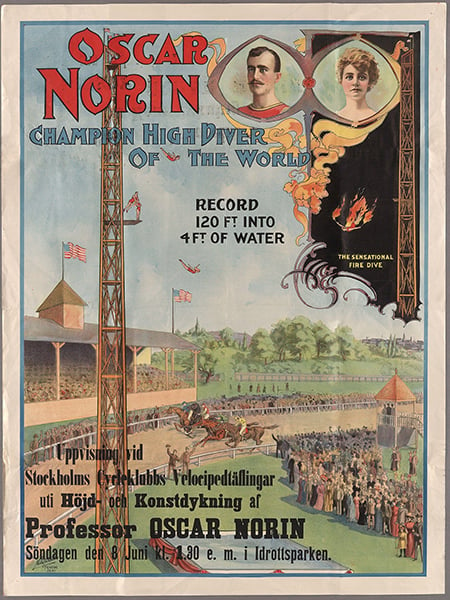
Beyond the checks she wrote, beyond the multitude of thoughtful gifts and gestures, the deeper manifestation of Mrs. Eddy’s philanthropy was her healing work.
This extended far beyond Concord, New Hampshire, of course — but her hometown and its residents also benefited greatly from her prayerful contributions. There was the nearby farmer whose well had run dry one winter, for instance, and found it suddenly full the morning after Mrs. Eddy was told of his predicament.61 There was the 16-year-old neighbor girl whom she healed of tuberculosis,62 and the visiting New York journalist who was cured of a painful growth, among many other examples.63 And then there was Oscar Norin.
It was a meeting that biographer Robert Peel suggests was “a matter of professional interest”64 — Mrs. Eddy wanting to know more about the fearlessness that Mr. Norin exhibited in his high dives. Clara Shannon, a First Member and frequent household worker at Pleasant View, was present the day Norin came to call. As she remembers, he showed up wearing dark goggles because of a severely damaged eye. Mrs. Eddy asked him “if he were not afraid when he took that leap. He explained to her that if he were to become afraid the jump was too high, he would be killed. After [she had talked] to him in a most heavenly way for some time, one could see by the expression of his face how enlightened he was mentally.”
The two continued talking about his lack of fear and its relation to his successful high dives. Mrs. Eddy then said to him, “Why not apply the same rule to your eyes?”
“They were sitting in the library,” Miss Shannon continues, “and as she talked to him, I could see and feel that his fear was removed, and his thought was full of hope and joy, although he did not then realize the blessing he had received.”
The healing was confirmed by the cab driver who took Norin to the station after the fair was over, and later, says Miss Shannon, Norin “wrote to Mrs. Eddy telling her of the wonderful healing he had experienced and expressing his gratitude.”65
“Philanthropy,” Mary Baker Eddy wrote, “is loving, ameliorative, revolutionary….”66
Her words, written in a letter published on New Year’s Day 1901, ring true as a barometer of her own life and actions. From the quiet generosity of a loving heart that spilled over into kind deeds to friends and neighbors, to her more public support of civic improvement, to the revolutionary Science that she gave the world — a Science that sprang from the radical Christianity which Jesus modeled in upending both conventional theology and the tyranny of the material senses — Mrs. Eddy’s example endures. And of the philanthropist? She concluded in that same letter, “his life’s incentive and sacrifice need no apology. The good done and the good to do are his ever-present reward.”
